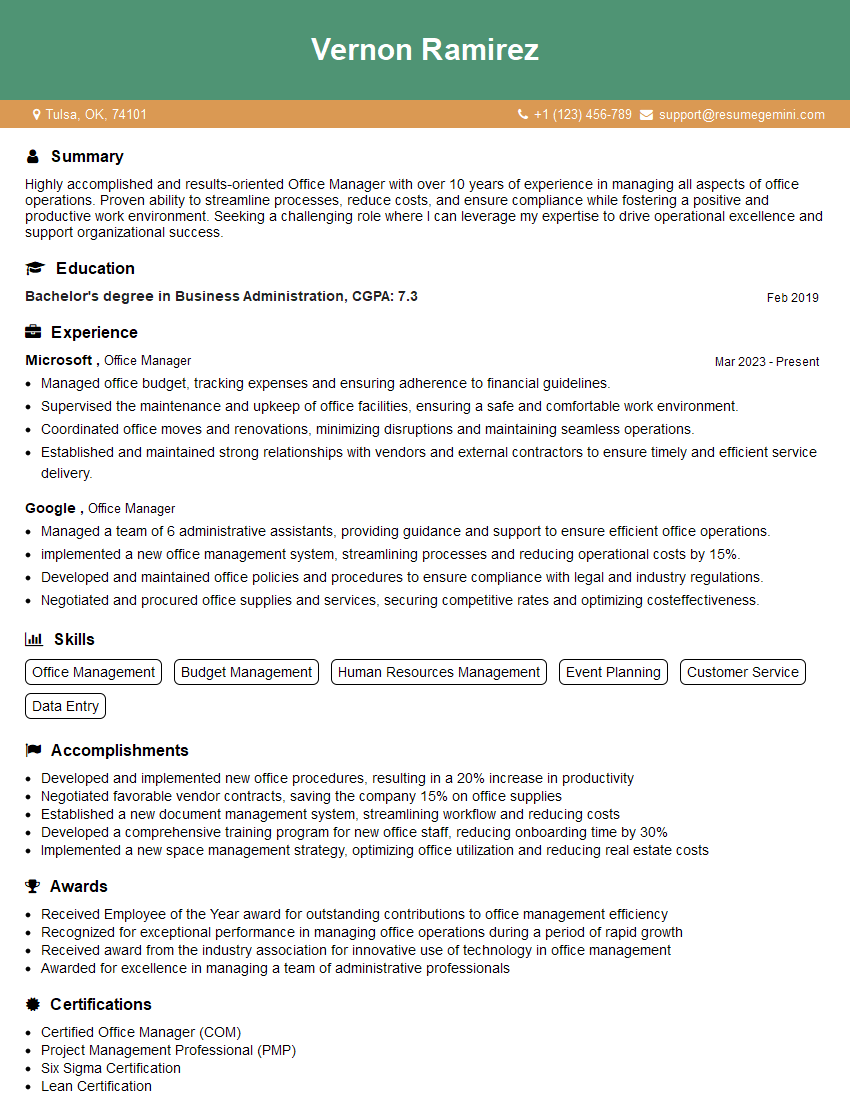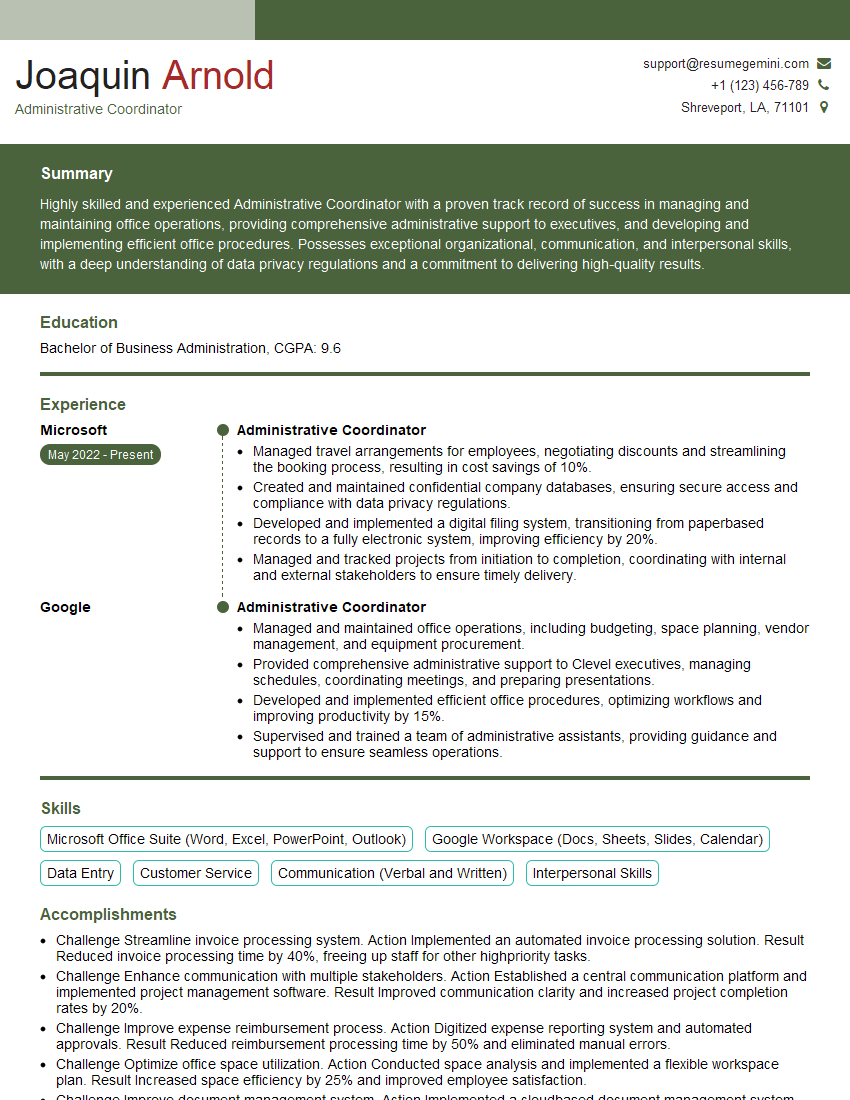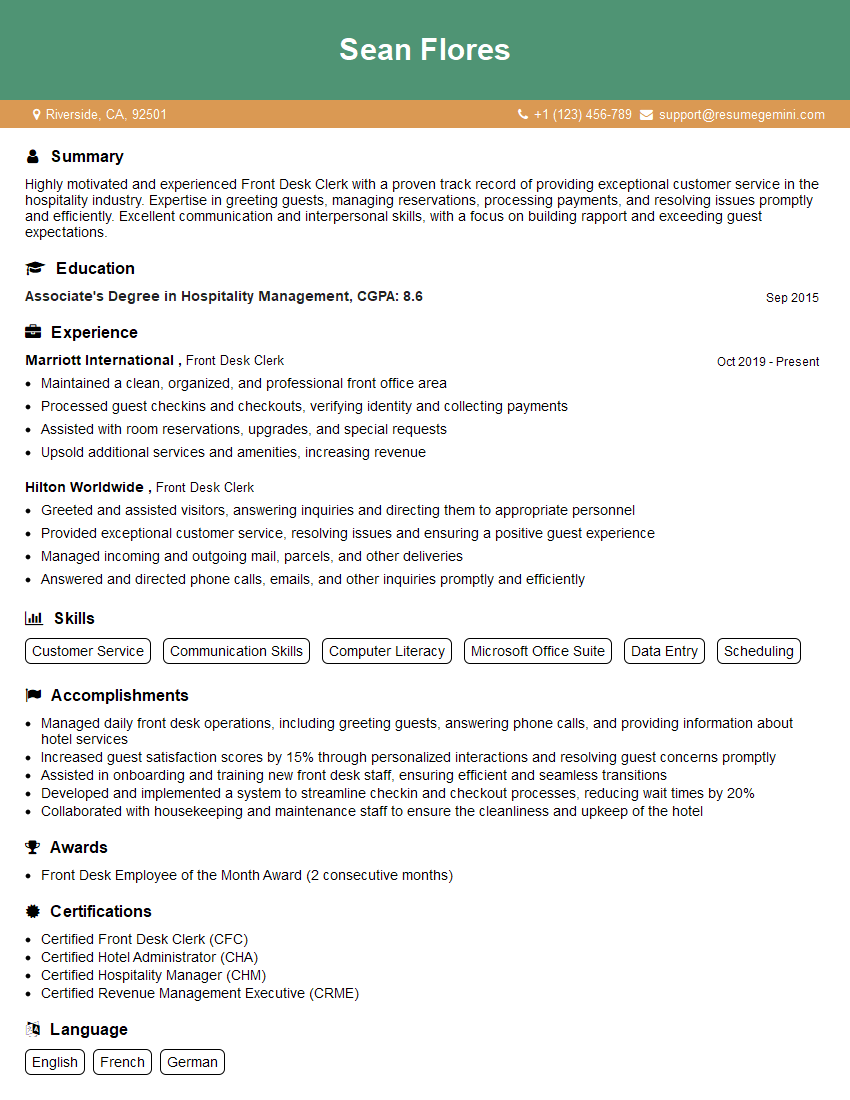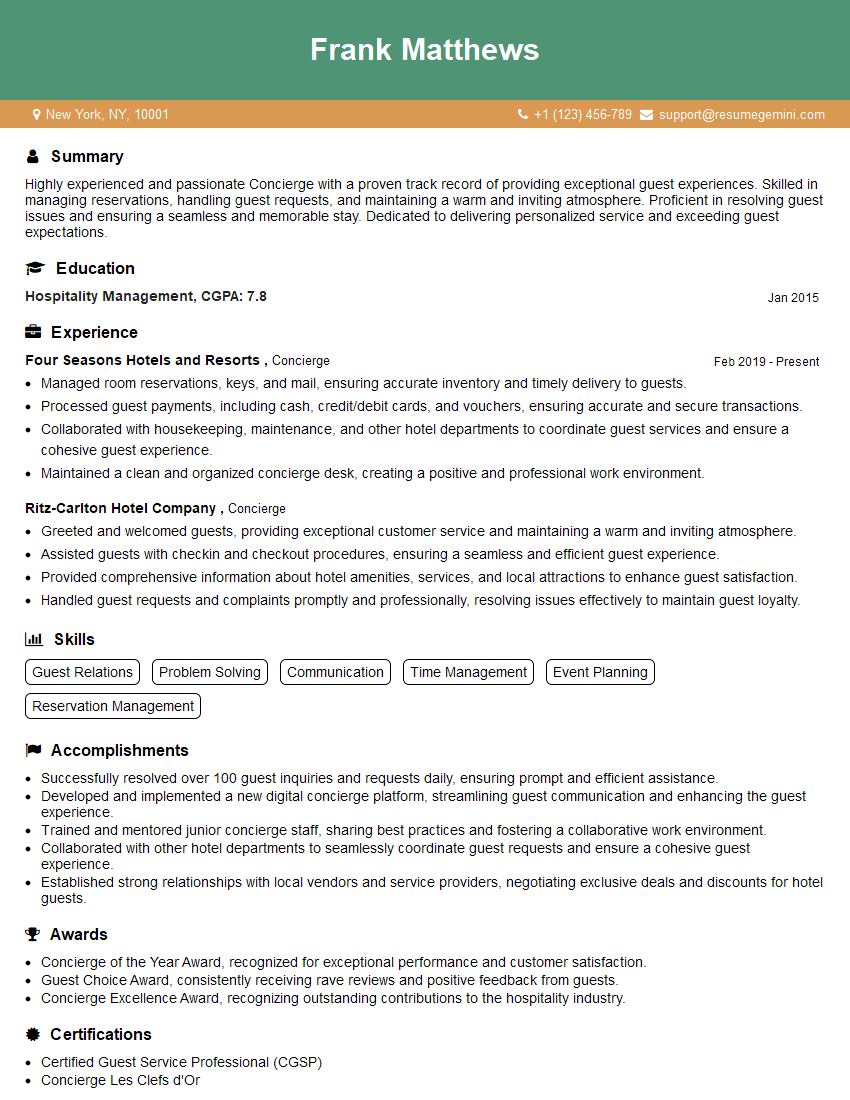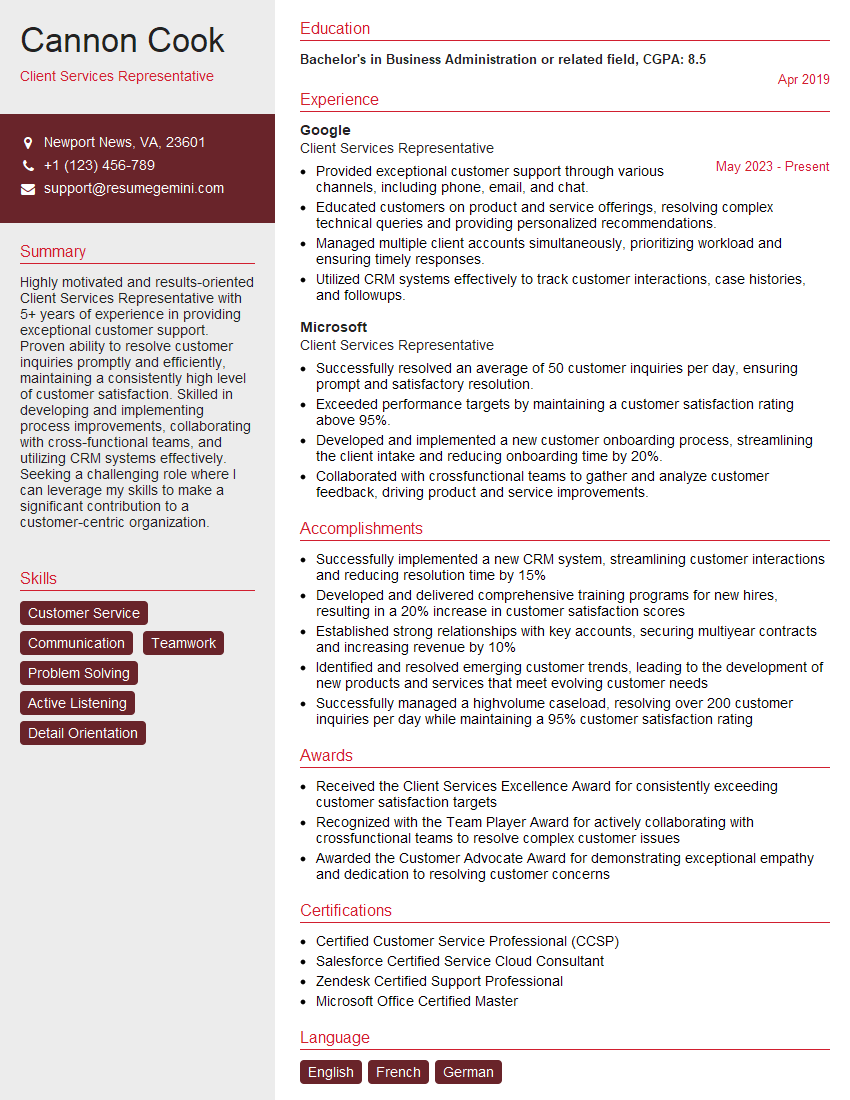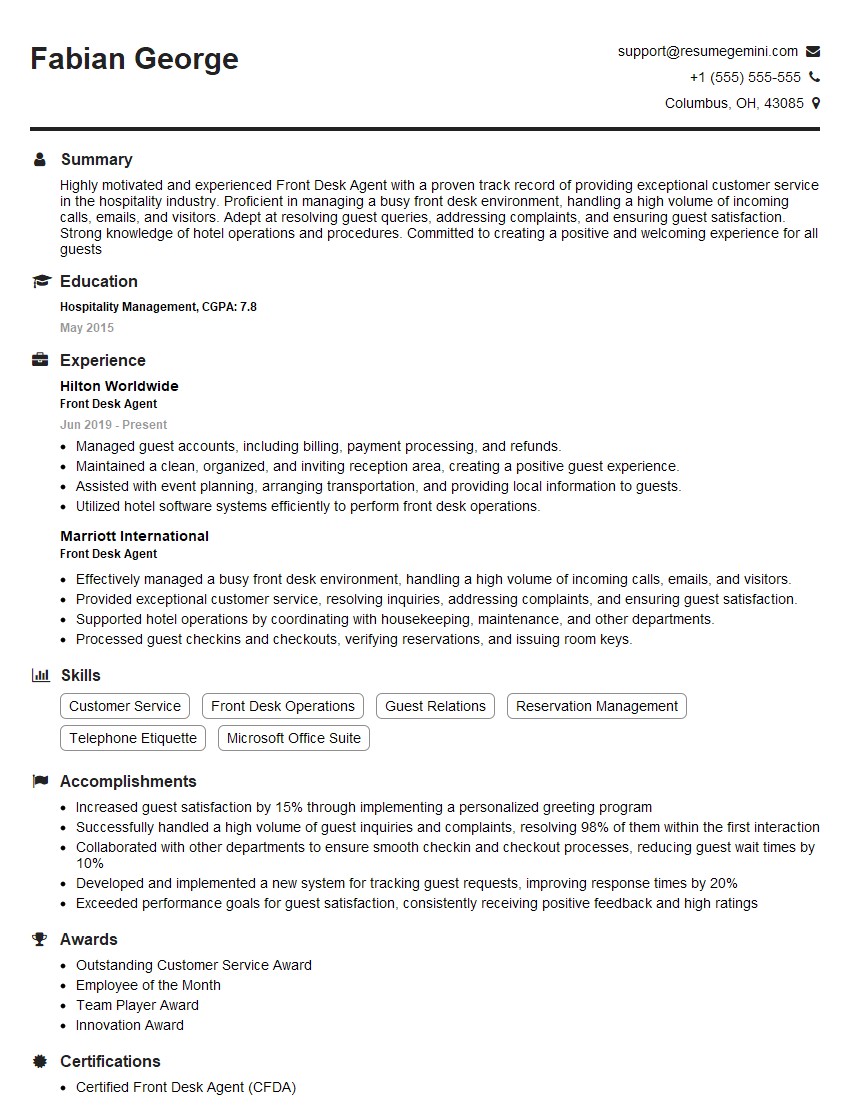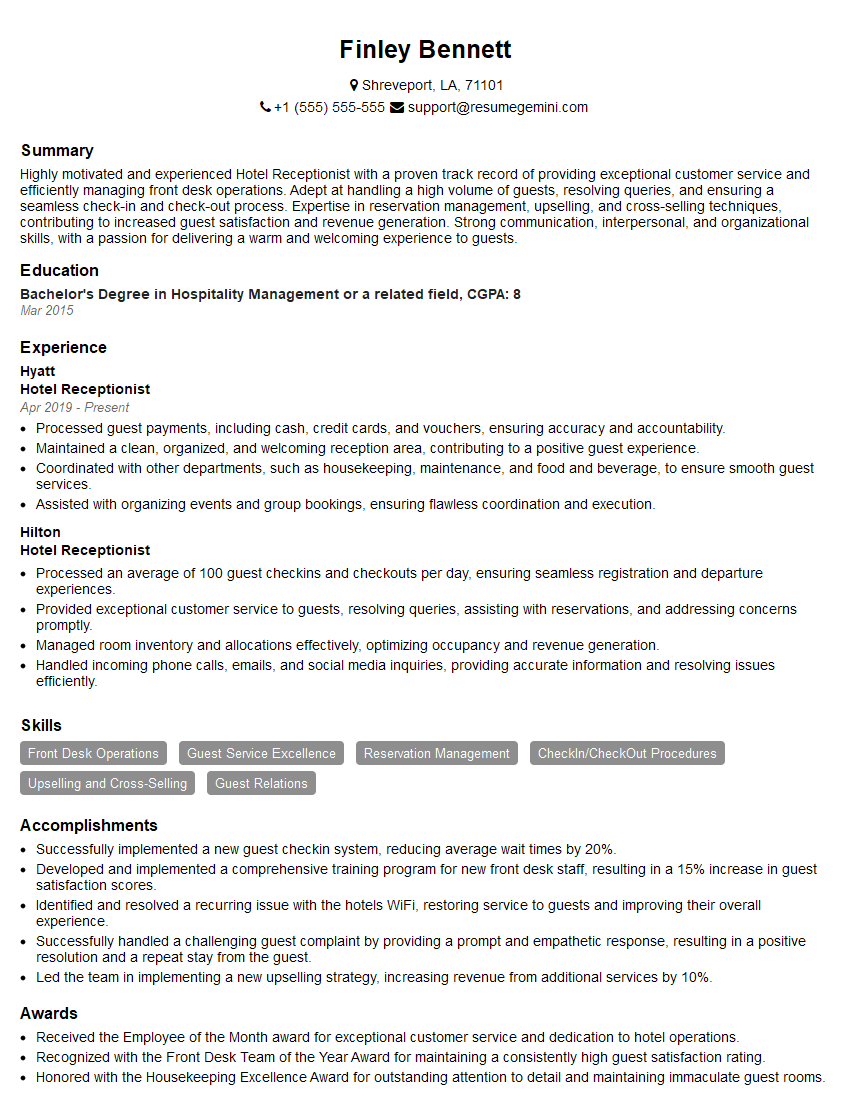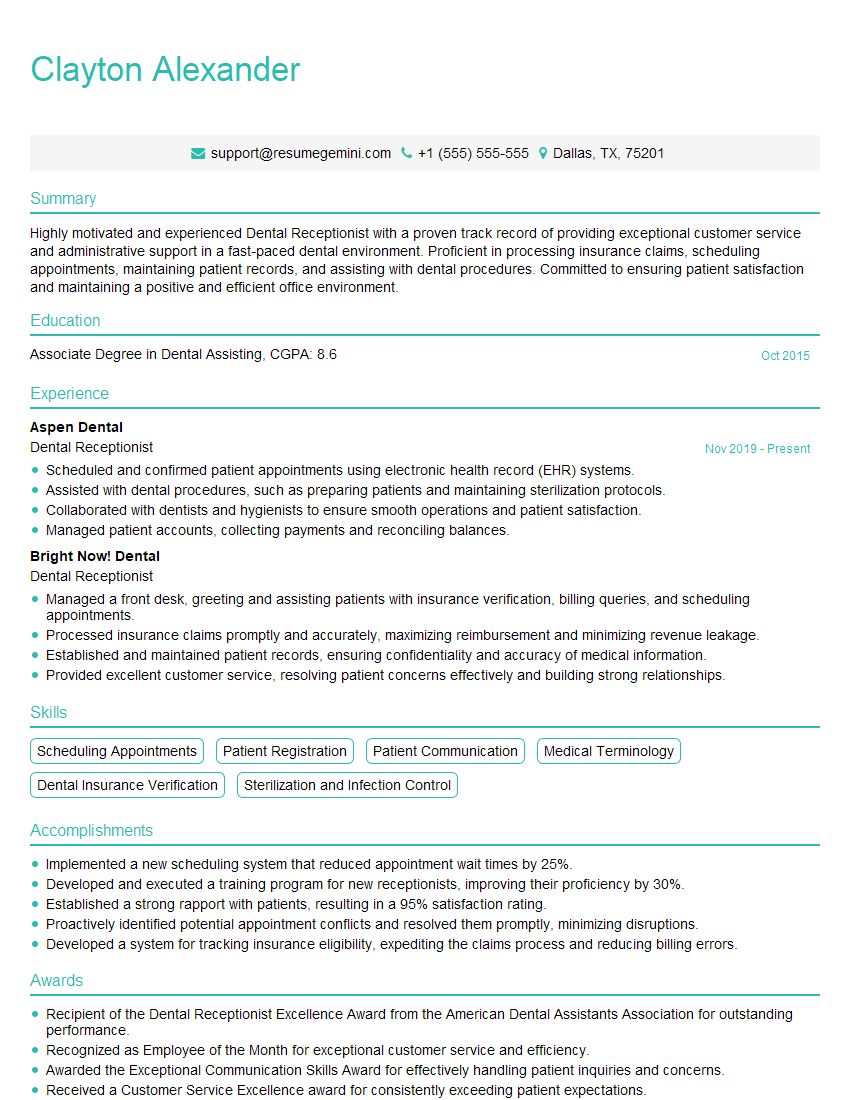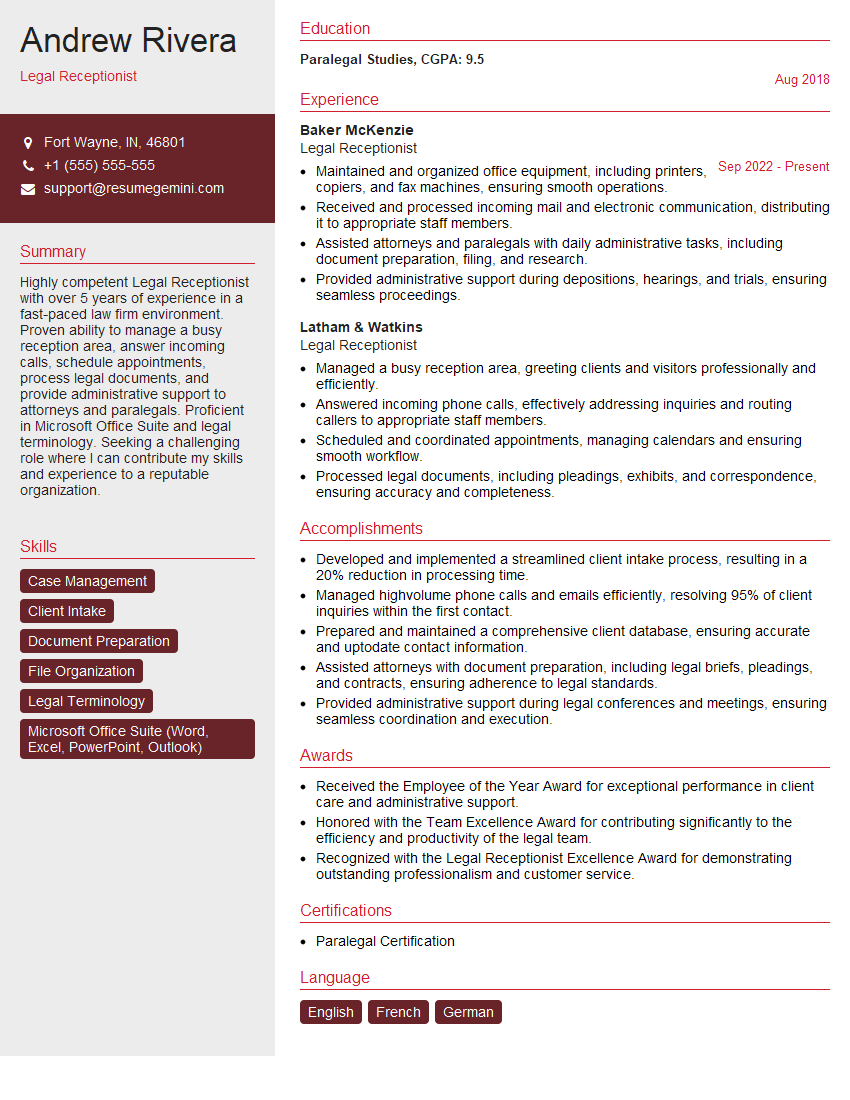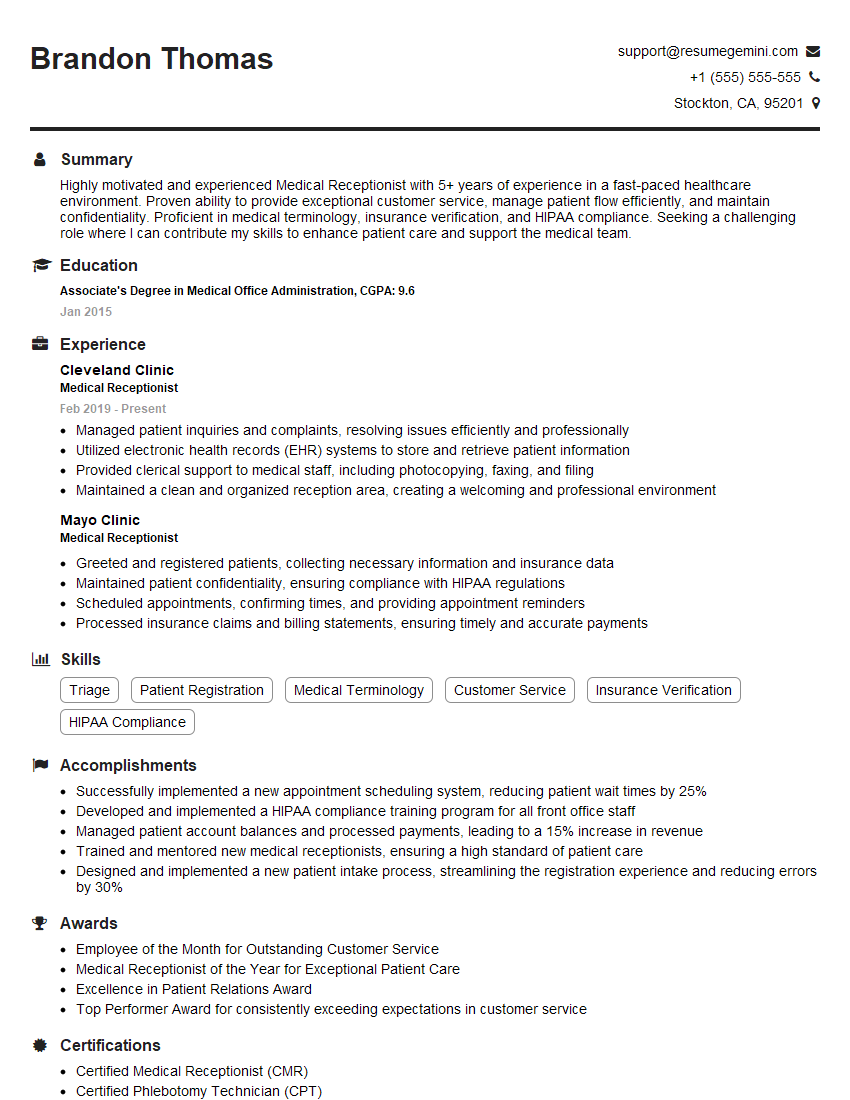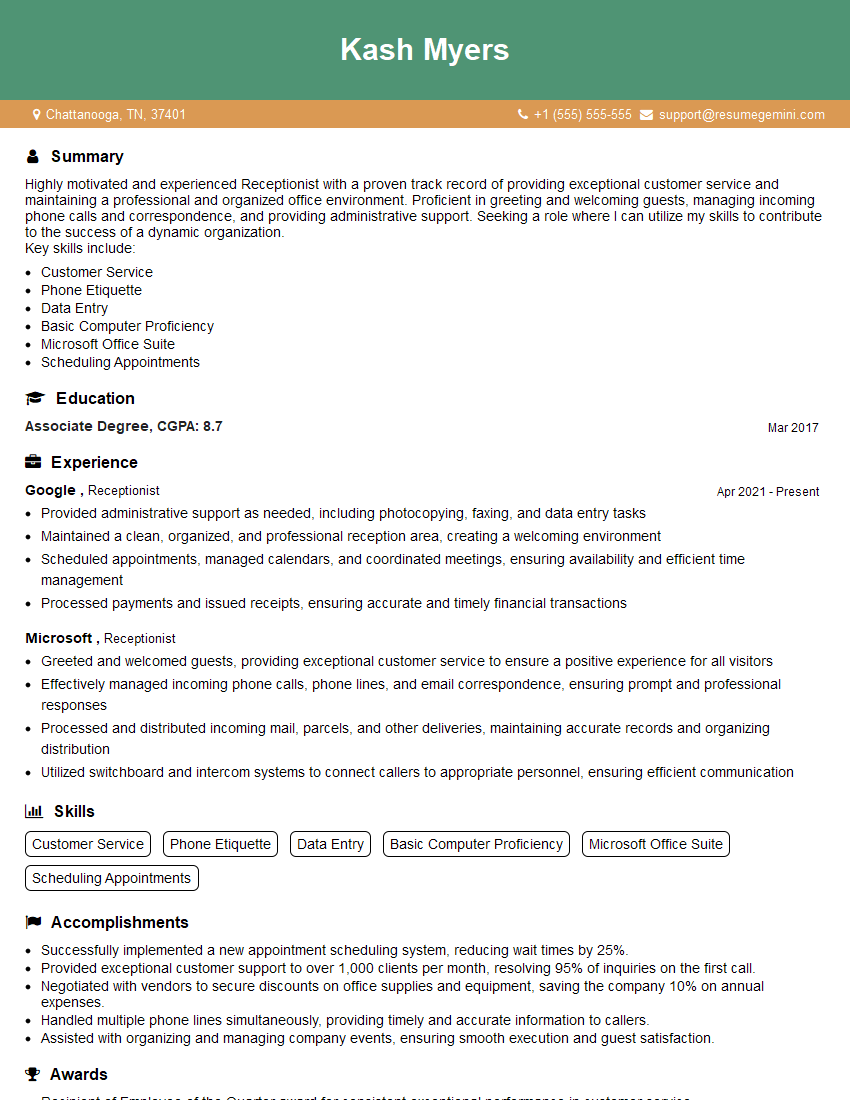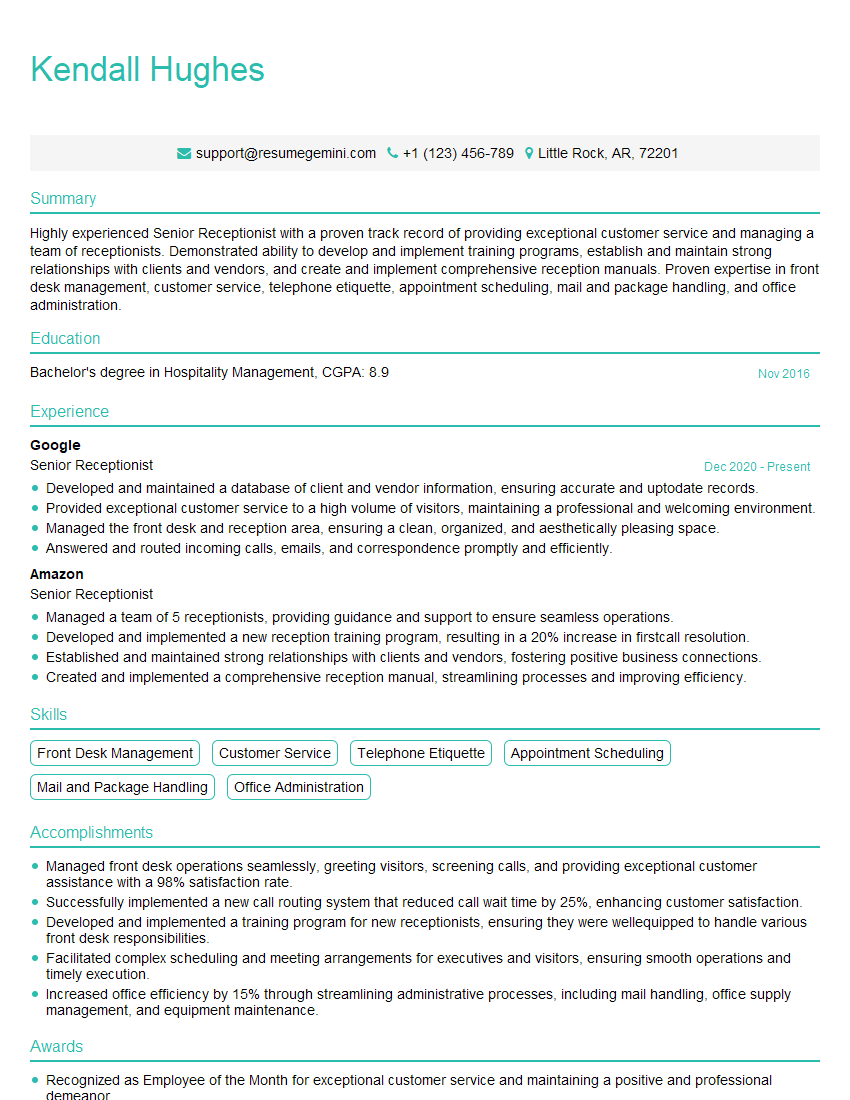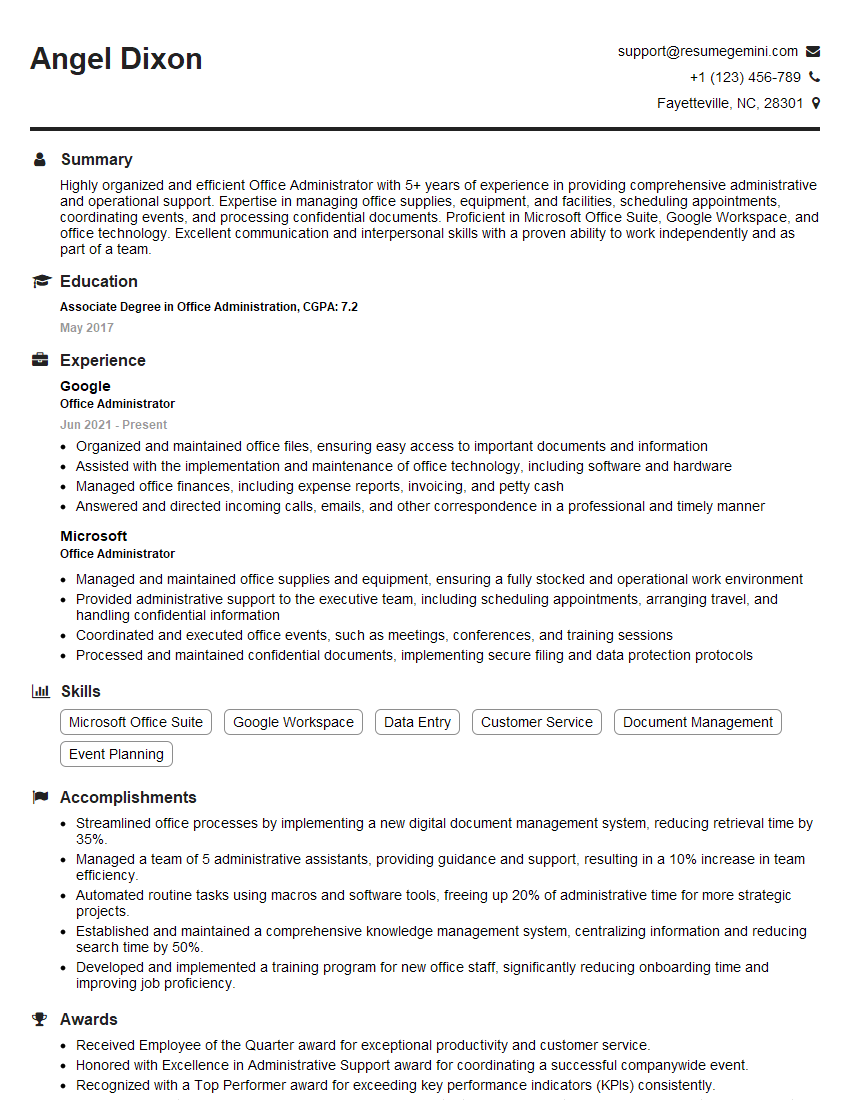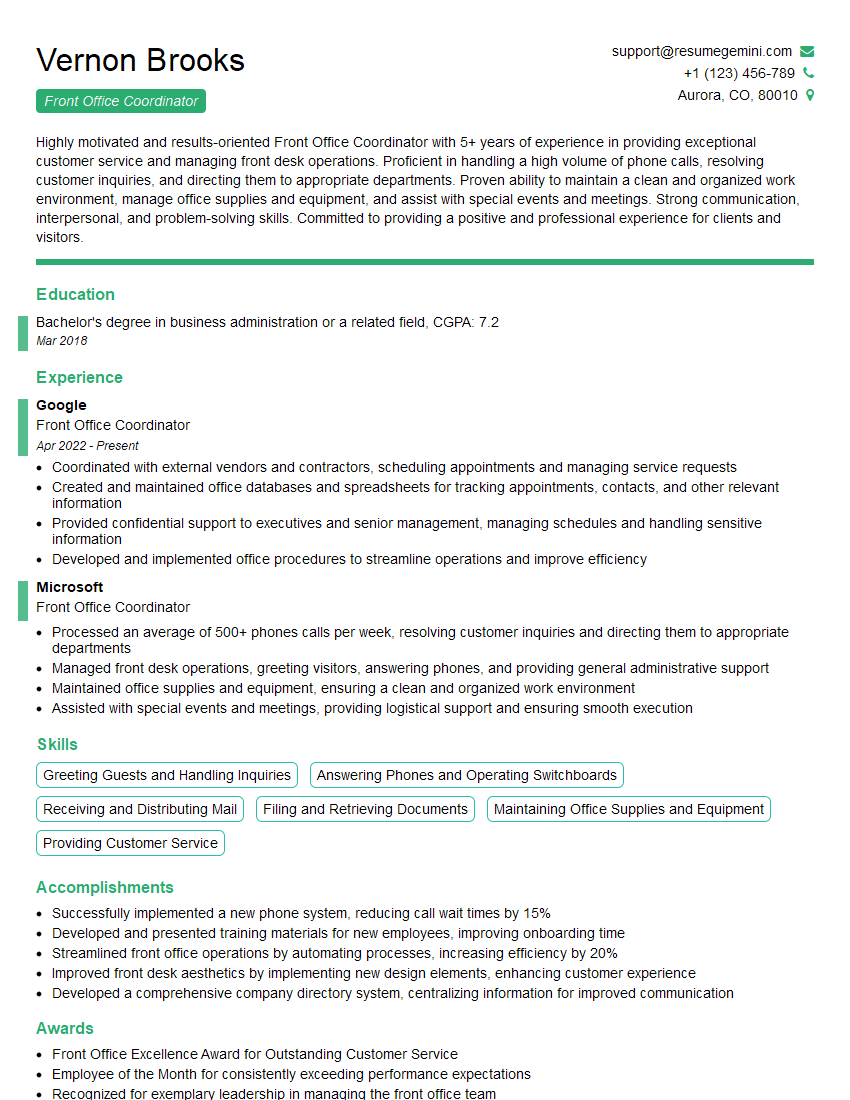The thought of an interview can be nerve-wracking, but the right preparation can make all the difference. Explore this comprehensive guide to Maintaining Reception Area interview questions and gain the confidence you need to showcase your abilities and secure the role.
Questions Asked in Maintaining Reception Area Interview
Q 1. Describe your experience maintaining a clean and organized reception area.
Maintaining a pristine and organized reception area is crucial for creating a positive first impression. My approach is multifaceted, encompassing proactive cleaning, strategic organization, and consistent attention to detail.
For instance, in my previous role at Acme Corp, I implemented a daily cleaning schedule including wiping down surfaces, vacuuming, and emptying trash cans. Beyond the daily routine, I also conducted weekly deeper cleans, which involved dusting high-level surfaces, cleaning windows, and disinfecting frequently touched areas. This preventative approach minimized the accumulation of dirt and clutter, resulting in a consistently welcoming environment. I also implemented a system for organizing brochures and informational materials, ensuring they were always neatly presented and easily accessible to visitors.
Furthermore, I proactively addressed potential issues, such as spills or damaged furniture, immediately to avoid creating a negative impression. For example, I established a quick response protocol for minor accidents that included immediate cleanup and reporting to the facilities team.
Q 2. How do you handle multiple phone lines and incoming calls simultaneously?
Handling multiple phone lines simultaneously requires a combination of efficient prioritization and effective communication skills. I utilize a multi-line phone system, prioritizing calls based on urgency and caller type. For instance, emergency calls always take precedence, followed by calls from existing clients, and lastly, general inquiries.
To enhance efficiency, I employ techniques such as putting callers on hold briefly while addressing pressing matters, using call-waiting features, and taking concise messages when necessary. I always strive to provide clear and concise communication to ensure the caller’s needs are understood and addressed effectively. I also make it a point to note any crucial information from the calls in a system of our choice (e.g., CRM).
I find that a calm and professional demeanor helps manage the stress of handling multiple calls concurrently. It’s about being organized and focused, using available technology and systems.
Q 3. Explain your proficiency in using reception area software and systems.
I’m proficient in using a variety of reception area software and systems, including appointment scheduling software, visitor management systems, and CRM (Customer Relationship Management) platforms. My experience spans various systems, from simple calendar-based schedulers to sophisticated cloud-based platforms.
For instance, at my previous role, we utilized a visitor management system that integrated with our security system, allowing for seamless check-in and access control. I’m comfortable inputting and retrieving data, generating reports, and utilizing system features for tasks such as appointment scheduling, contact management, and tracking of incoming mail. I also have experience with several cloud-based CRM systems, using these to input information and ensure proper contact information is up-to-date and readily available for colleagues.
I am adept at learning new systems quickly and adapting to evolving technological advancements in the field. I approach software training with a proactive and positive attitude, and I am a quick learner.
Q 4. How do you manage visitor check-in and sign-in procedures effectively?
Effective visitor check-in and sign-in procedures are vital for security and organization. My approach involves a combination of welcoming professionalism, adherence to company policy, and a keen eye for detail.
I always greet visitors with a friendly smile and welcoming attitude, quickly and professionally guiding them through the check-in process. This includes obtaining necessary information, such as name, company, and purpose of visit. I utilize the company’s visitor management system, which typically includes visitor logs for tracking and security purposes. I also ensure visitors receive appropriate identification badges and are directed to the appropriate individual or area.
In the event of unexpected or unauthorized visitors, I follow established protocol and contact relevant personnel immediately, maintaining a calm and professional demeanor. Clear communication throughout the process is key, ensuring both security and visitor satisfaction.
Q 5. Describe your experience handling mail and deliveries.
Handling mail and deliveries involves meticulous organization and careful attention to detail to ensure efficiency and accuracy. My approach includes establishing a clear system for sorting, logging, and distributing mail and packages.
I usually create a dedicated area for incoming mail and deliveries, ensuring items are kept organized and secured. I typically log all packages and mail, noting sender, recipient, and date of receipt. I carefully sort mail and packages, prioritizing urgent items and those requiring immediate action. I always ensure to obtain a signature upon delivery to confirm receipt. I’m familiar with various courier services and tracking procedures.
In situations where deliveries are damaged or missing, I follow established protocols for reporting and filing claims. Maintaining accurate records is essential for accountability and tracing issues if they arise.
Q 6. How do you prioritize tasks in a busy reception area?
Prioritizing tasks in a busy reception area is essential for maintaining efficiency and professionalism. I utilize a combination of time management techniques and organizational skills to ensure that tasks are handled effectively. I typically start my day by reviewing my schedule and tasks to identify urgent and important items. I often use a to-do list to keep track of tasks and prioritize them based on urgency and importance.
For instance, I prioritize urgent calls and requests over routine tasks, ensuring that time-sensitive matters are addressed promptly. I also use techniques like time blocking, allocating specific time slots for particular tasks, to enhance efficiency and prevent interruptions. In scenarios with competing priorities, I often engage in quick assessments to choose the most impactful task to tackle first.
Flexibility is key in a reception area. I always remain adaptable, adjusting my priorities as needed to handle unforeseen events or urgent requests.
Q 7. How do you handle difficult or irate visitors or callers?
Handling difficult or irate visitors or callers requires patience, empathy, and effective communication skills. My approach focuses on active listening, de-escalation, and finding appropriate solutions.
I start by actively listening to the visitor or caller, allowing them to express their concerns without interruption. I maintain a calm and professional demeanor, using empathetic language to acknowledge their frustration. I try to understand their perspective and address their concerns directly. If needed, I will offer solutions or refer the matter to the appropriate person.
If the situation escalates beyond my ability to handle, I will politely inform the individual I will need to seek assistance from a supervisor. Documentation of such incidents is essential and is reported following company policy.
Q 8. What methods do you use to ensure the reception area is presentable and welcoming?
Maintaining a presentable and welcoming reception area is crucial for creating a positive first impression. It involves a multi-pronged approach focusing on cleanliness, organization, and aesthetics.
- Cleanliness: Regular cleaning is paramount. This includes dusting, vacuuming, and sanitizing surfaces throughout the day, especially high-touch areas like door handles and countertops. I also ensure trash cans are emptied regularly and that the area is free of clutter.
- Organization: A well-organized reception area is essential. Literature should be neatly displayed, brochures should be current, and any necessary signage should be clear and easy to understand. I maintain a system for managing incoming and outgoing mail and packages efficiently.
- Aesthetics: The visual appeal matters greatly. This includes ensuring that plants are watered and healthy, that the lighting is appropriate, and that the décor is up-to-date and inviting. A pleasant scent can also make a difference, though it should be subtle and non-allergenic.
For example, I once implemented a daily checklist for reception area maintenance, ensuring consistent standards and minimizing the risk of overlooking tasks. This led to consistently positive feedback from clients and visitors.
Q 9. How familiar are you with office equipment, such as copiers and fax machines?
I’m highly proficient with common office equipment, including copiers, fax machines, and printers. My experience encompasses not only using these machines but also troubleshooting minor issues and performing routine maintenance tasks.
- Copiers: I am skilled in operating various copier models, making copies, scanning documents, and utilizing advanced features like collating and stapling. I can also troubleshoot common problems like paper jams and toner replacements.
- Fax Machines: I am adept at sending and receiving faxes, ensuring documents are properly formatted and transmitted clearly. I understand the importance of maintaining a fax log and following confidentiality protocols.
- Printers: I’m familiar with various printer types and their functionalities, including handling different paper sizes and types. I can manage ink or toner levels and address simple printing errors.
In a previous role, I successfully resolved a recurring copier jam issue by identifying the source of the problem—a misaligned paper tray—saving the company time and expense on service calls.
Q 10. Describe your experience managing appointment scheduling and calendars.
Managing appointments and calendars is a core part of my reception duties. I use a combination of technology and organizational skills to ensure smooth scheduling.
- Calendar Management: I utilize electronic calendars (like Google Calendar or Outlook Calendar) to schedule appointments, meetings, and other events. I understand the importance of accurately recording details such as time, date, participants, and purpose.
- Appointment Scheduling: I efficiently schedule appointments by phone, email, or in person, ensuring there are no scheduling conflicts. I confirm appointments with individuals and update calendars accordingly.
- Double-Booking Prevention: I implement strategies to prevent double-booking, such as color-coding appointments on the calendar and utilizing appointment scheduling software with built-in conflict alerts.
For instance, I developed a system using color-coded appointment types in our calendar which made identifying and managing high-priority meetings much easier and reduced potential for conflicts.
Q 11. How do you maintain confidentiality of sensitive information in the reception area?
Confidentiality is paramount in a reception area. I adhere to strict protocols to safeguard sensitive information.
- Privacy Practices: I never leave sensitive documents unattended and ensure they are stored securely when not in use. I never share information with unauthorized individuals and always treat all information as confidential.
- Secure Document Handling: I use secure methods for shredding confidential documents, and I am trained on appropriate procedures for handling sensitive mail and packages.
- Visitor Management: I ensure visitors sign in and out, restricting access to sensitive areas of the office. I always ask for identification when needed.
I once prevented a potential breach by noticing a visitor looking at confidential documents on an unattended desk. I immediately intervened, ensuring that the documents were secured and promptly reported the incident to management.
Q 12. How do you handle situations where you need to direct calls or visitors to the appropriate personnel?
Directing calls and visitors efficiently requires a strong understanding of the organization’s structure and personnel.
- Phone Etiquette: I answer the phone professionally, identifying myself and the company. I efficiently direct calls by asking clarifying questions and verifying the caller’s needs before transferring the call to the appropriate individual or taking a detailed message.
- Visitor Guidance: I welcome visitors courteously, obtaining their name and purpose of visit. Using a directory or internal system, I direct visitors to the appropriate person or department, sometimes escorting them if needed.
- Emergency Situations: I am trained to handle emergency situations, knowing which staff to contact in case of a medical emergency or other urgent matter.
In one instance, a confused visitor couldn’t find the correct department. By asking clarifying questions, I was able to quickly ascertain their need and personally escort them to the right office, enhancing their overall experience.
Q 13. What strategies do you employ to ensure smooth and efficient workflow in the reception area?
Smooth and efficient workflow in the reception area is achieved through planning, organization, and proactive problem-solving.
- Prioritization: I prioritize tasks based on urgency and importance, ensuring that urgent requests are addressed promptly and efficiently. I handle multiple tasks simultaneously, often using task management tools to ensure nothing slips through the cracks.
- Process Improvement: I regularly evaluate processes and identify areas for improvement to streamline operations. I am proactive in suggesting improvements to increase efficiency and reduce bottlenecks.
- Teamwork: I communicate effectively with colleagues in other departments to ensure smooth collaboration and information flow.
By implementing a simple system for managing incoming deliveries, I significantly reduced the time spent processing packages and improved overall efficiency.
Q 14. How do you manage your time effectively in a high-volume reception area?
Managing time effectively in a high-volume reception area requires strong organizational skills and a proactive approach.
- Time Management Techniques: I use time management techniques such as prioritizing tasks, setting deadlines, and breaking down large tasks into smaller, more manageable ones.
- Multitasking: I can efficiently multitask, handling incoming calls, greeting visitors, and managing administrative tasks simultaneously.
- Proactive Problem Solving: I anticipate potential delays or bottlenecks and proactively address them to maintain a smooth workflow. I also delegate tasks when appropriate.
I once successfully managed a period of unusually high call volume during a major company event by prioritizing calls and working collaboratively with colleagues to ensure everyone received timely assistance.
Q 15. Describe your experience with maintaining reception area supplies and inventory.
Maintaining reception area supplies and inventory requires a systematic approach. I’ve always utilized a combination of physical inventory checks and digital tracking systems. For instance, in my previous role, I implemented a spreadsheet system in Excel to track stationery items like pens, paper, and envelopes, as well as coffee, tea, and other consumables. This spreadsheet included columns for item name, quantity on hand, reorder point, supplier information, and last order date. Regularly checking supplies against this inventory allows for timely reordering, preventing stockouts. I also implemented a visual system with color-coded labels on shelves, indicating low stock levels, which provides a quick, at-a-glance inventory overview for everyone in the office.
Beyond the spreadsheet, I conduct a physical inventory check at least once a month, comparing physical quantities to the spreadsheet data. This helps identify discrepancies, potential losses, or outdated information in the tracking system. I also work closely with procurement to negotiate favorable pricing and ensure efficient delivery schedules. This multi-pronged approach ensures we always have the necessary supplies on hand while minimizing waste and unnecessary expenses.
Career Expert Tips:
- Ace those interviews! Prepare effectively by reviewing the Top 50 Most Common Interview Questions on ResumeGemini.
- Navigate your job search with confidence! Explore a wide range of Career Tips on ResumeGemini. Learn about common challenges and recommendations to overcome them.
- Craft the perfect resume! Master the Art of Resume Writing with ResumeGemini’s guide. Showcase your unique qualifications and achievements effectively.
- Don’t miss out on holiday savings! Build your dream resume with ResumeGemini’s ATS optimized templates.
Q 16. How do you handle emergency situations in the reception area?
Handling emergency situations in a reception area requires quick thinking and calm professionalism. My approach is based on a three-step process: Assess, Act, and Alert. First, Assess the situation – is it a medical emergency, a security threat, a fire, or something else? Understanding the nature of the emergency dictates my next steps.
Next, Act. For instance, if it’s a medical emergency, I would immediately call emergency services (911 or the local equivalent) and provide clear information about the location, nature of the emergency, and the individual’s condition. I’d also offer first aid if I’m trained to do so, while ensuring the safety of others in the reception area. In case of a fire, I’d follow the building’s fire evacuation plan, ensuring everyone is safely evacuated and accounted for.
Finally, Alert the appropriate individuals – my supervisor, building management, or security personnel – depending on the situation. I’d then document the incident, including the time, the nature of the emergency, actions taken, and any other relevant information. Regular training on emergency procedures, including CPR and first aid, is vital for effectively managing such situations.
Q 17. How do you ensure the security of the reception area and office building?
Reception area security is paramount. I’ve consistently implemented measures to ensure the safety of both visitors and staff. This includes maintaining a visitor log, ensuring the reception area is well-lit and free from obstructions, and being vigilant about monitoring who enters and exits the building.
I use access control systems (keycard or biometric) effectively and adhere strictly to procedures for granting access to visitors. I also make sure to regularly check security cameras and report any suspicious activity to building security or relevant authorities. Regular security audits and drills are essential to proactively identify and mitigate potential vulnerabilities. Training all staff on security procedures, emphasizing the importance of visitor identification and reporting unusual events, further strengthens security measures. Clear signage regarding security protocols and emergency exits is also crucial for a safe and secure environment.
Q 18. Explain your experience with customer service protocols in a reception area setting.
Customer service in a reception area is the first impression a visitor has of an organization. I prioritize providing a welcoming and efficient experience. This begins with greeting each visitor with a warm smile and friendly demeanor, regardless of the reason for their visit. I make sure to actively listen to their needs, answer their queries accurately and promptly, and direct them to the appropriate individual or department. I handle all calls with the same professionalism, ensuring clear and concise communication.
I am adept at handling challenging situations with grace and professionalism. This includes remaining calm under pressure, addressing complaints empathetically and effectively, and finding solutions to problems, if possible. Maintaining a calm, professional approach even in tense situations demonstrates competence and commitment to excellent customer service. In my experience, a positive initial interaction significantly improves the visitor’s overall experience.
Q 19. How do you build rapport with visitors and clients?
Building rapport involves creating a positive and trustworthy connection. I achieve this through active listening, genuine interest, and friendly conversation. I make a conscious effort to make each visitor feel welcome and valued. For example, I might start by offering them a beverage and engage in small talk – commenting on the weather, a recent event, or something positive to create a relaxed atmosphere.
Beyond pleasantries, showing genuine interest in the reason for their visit fosters connection. By actively listening and addressing their needs promptly, I show respect for their time and demonstrate my commitment to providing excellent service. Remembering details about previous visits or remembering their names also enhances the personal touch and builds trust. A friendly, professional manner can go a long way in building positive relationships with visitors and clients, making them feel comfortable and valued.
Q 20. How do you troubleshoot common reception area technical issues?
Troubleshooting common reception area technical issues requires a practical and systematic approach. My experience includes resolving issues related to printers, computers, internet connectivity, and phone systems. I typically follow a troubleshooting methodology: First, identify the problem and gather information – What’s not working? When did it stop working? Any error messages?
Next, I try simple solutions: Check cables, restart devices, check internet connection, etc. If simple solutions fail, I escalate the issue to the IT department, providing them with detailed information about the problem and my troubleshooting attempts so far. I keep a log of all technical issues and solutions, which helps identify recurring problems and improve preventative measures. Familiarity with basic computer software and networking concepts is crucial, and ongoing training keeps my skills current.
Q 21. How proficient are you in Microsoft Office Suite applications (Word, Excel, Outlook)?
I am highly proficient in the Microsoft Office Suite applications, including Word, Excel, and Outlook. I utilize Word for creating professional documents such as visitor logs, reports, and correspondence. My Excel skills extend to data management, including inventory tracking, as previously described, as well as creating charts and graphs for reporting purposes. Outlook is integral to my daily workflow for managing emails, appointments, and scheduling meetings.
I use these applications to streamline my tasks and improve efficiency. For example, I use Excel’s formula functions to automate repetitive tasks related to inventory tracking and reporting. In Outlook, I manage my email effectively to ensure all communications are dealt with promptly and professionally. My expertise in these applications makes me highly efficient in my role and allows me to perform many administrative tasks independently.
Q 22. Describe your experience with managing and maintaining reception area databases or spreadsheets.
Managing reception area data effectively is crucial for smooth operations. My experience involves utilizing both databases and spreadsheets, depending on the organization’s size and needs. In smaller settings, a well-organized spreadsheet, perhaps using Microsoft Excel or Google Sheets, suffices. I’m proficient in creating and maintaining spreadsheets with columns for visitor information (name, company, purpose of visit, contact details, time of arrival/departure), appointment scheduling, and staff contact information. For larger organizations, I’ve worked with database systems – in particular, I have experience with [mention specific database software e.g., Access, FileMaker Pro] – allowing for more sophisticated data management, reporting, and integration with other systems. These databases often include features for searching, filtering, and generating reports on visitor traffic patterns or identifying frequent visitors.
For example, in my previous role at [Previous Company Name], I developed an Excel spreadsheet to track visitor sign-ins, which also generated a monthly report summarizing visitor volume and purpose of visits. This data proved invaluable in planning staffing levels and improving reception area efficiency. In a later role at [Another Previous Company Name], I managed a database that integrated with our calendar system, allowing for seamless scheduling of appointments and automated reminders.
Q 23. How do you maintain a professional and courteous demeanor at all times?
Maintaining a professional and courteous demeanor is paramount in a reception area. It’s the first impression a visitor receives of the company. I achieve this through several key strategies. First, I always greet visitors with a warm smile and a confident, welcoming tone. I actively listen to their needs and address them with empathy and respect, regardless of the situation. Second, I prioritize clear and concise communication. I ensure my language is professional and avoid using jargon or slang. Third, I maintain a calm and composed manner, even under pressure. This means managing my own stress and remaining patient, even when dealing with challenging individuals. Finally, I ensure my personal appearance is always neat and professional, adhering to company dress code guidelines.
For example, if a visitor is frustrated due to a delay, I would acknowledge their frustration and offer sincere apologies, then proactively inform them of the estimated waiting time and offer them a comfortable seating area or refreshments. By actively listening and demonstrating empathy, I can often defuse tense situations and maintain a positive interaction.
Q 24. What are your strategies for resolving conflict situations in the reception area?
Conflict resolution in the reception area requires a calm and diplomatic approach. My strategy focuses on active listening, empathy, and finding mutually agreeable solutions. First, I would listen carefully to understand each person’s perspective without interrupting. Second, I would paraphrase their concerns to ensure understanding and show that I’m actively engaged. Third, I would identify the root cause of the conflict. Is it a misunderstanding, a scheduling issue, or something else? Once identified, I would work collaboratively to find a solution that addresses the concerns of all parties involved. If the conflict is beyond my scope to resolve, I would escalate it to the appropriate manager while keeping all involved parties informed.
For instance, I once had a situation where two visitors argued over who arrived first for an appointment. I calmly asked each to explain their situation, then checked the appointment schedule. It turned out there was a scheduling error. I apologized for the inconvenience, rescheduled one of the appointments, and offered complimentary coffee and refreshments to both while they waited. This defused the situation and prevented further escalation.
Q 25. How do you ensure the reception area meets company branding and image standards?
Ensuring the reception area reflects the company’s branding and image is vital for projecting a consistent and professional identity. This involves paying attention to several key areas. First, the physical space should be clean, organized, and well-maintained. This includes regular cleaning, ensuring furniture is in good condition, and maintaining a clutter-free environment. Second, the décor should align with the company’s branding guidelines. This might include specific color schemes, logos, and signage. Third, the materials used in the reception area, such as brochures and signage, should reflect the company’s branding and messaging. Finally, staff uniforms and appearance should also adhere to the company’s image guidelines.
In a previous role, we redesigned our reception area to reflect a newly launched company brand. This involved selecting new furniture, repainting the walls, installing new signage, and updating the company literature displayed. This involved close collaboration with the marketing department to ensure adherence to the brand guidelines.
Q 26. Describe your experience with different reception area layouts and configurations.
I have experience with various reception area layouts and configurations, from small, compact spaces to larger, more elaborate setups. I understand the importance of optimizing the layout to ensure efficient workflow and a positive visitor experience. For example, I’ve worked in reception areas with traditional desk setups, open-plan designs, and areas incorporating waiting lounges. I’ve also managed reception areas with different technological integrations, including visitor management systems, digital signage, and video conferencing capabilities.
My experience has taught me that the optimal layout depends on several factors, including the size of the space, the volume of visitors, the company culture, and the available technology. I am adept at assessing the needs of a specific organization and recommending a configuration that best suits its requirements.
Q 27. How do you adapt to changes in workflow or procedures in the reception area?
Adaptability is crucial in a reception area. Changes in workflow or procedures are inevitable, perhaps due to new technology, company restructuring, or changes in visitor volume. I approach these changes proactively. First, I actively listen to instructions during any training or communication regarding the changes. Second, I ask clarifying questions to ensure complete understanding before implementing the changes. Third, I organize my workspace and tasks accordingly, prioritizing efficiency and minimizing disruption. Fourth, I actively seek feedback to ensure the changes are working effectively and identify any areas for improvement.
For example, when our company implemented a new visitor management system, I quickly learned the new software, trained other reception staff, and assisted visitors during the transition. I was also proactive in suggesting workflow improvements based on my experience.
Q 28. Describe a time you had to solve a problem independently in a reception area setting.
In a previous role, the internet and phone lines went down unexpectedly during a critical meeting. This meant that visitors couldn’t be contacted, and internal communication was severely hampered. I immediately acted to mitigate the issue. I first contacted the IT department and provided them with the details of the outage. Then, I used a backup contact list to inform the visitors who were due to arrive shortly. I also used a company cell phone to make internal calls. I remained calm and reassuring to visitors, keeping them informed of the situation and providing alternative contact methods as needed. While waiting for the IT department to fix the problem, I used the time to prepare alternative work methods. The IT department restored the service quickly. My quick thinking and proactive approach ensured that the disruption was minimal, and I maintained a professional image of the company despite the unexpected technical difficulties.
Key Topics to Learn for Maintaining Reception Area Interview
- Creating a Welcoming Atmosphere: Understanding the importance of first impressions, nonverbal communication, and creating a positive and professional environment for visitors and colleagues.
- Reception Area Organization and Cleanliness: Practical application of maintaining a tidy, organized, and well-stocked reception area, including managing supplies, handling mail, and ensuring a visually appealing space.
- Efficient Communication and Telephone Etiquette: Answering phones professionally, taking accurate messages, transferring calls effectively, and utilizing appropriate communication techniques.
- Visitor Management and Reception Procedures: Handling visitor check-in and check-out processes, managing visitor logs, directing visitors appropriately, and addressing visitor inquiries effectively.
- Office Equipment and Technology Proficiency: Demonstrating familiarity with common office equipment (printers, copiers, fax machines) and relevant software (e.g., scheduling software). Problem-solving minor technical issues independently.
- Maintaining Confidentiality and Data Security: Understanding and adhering to company policies regarding confidentiality, data protection, and handling sensitive information.
- Time Management and Prioritization: Balancing multiple tasks simultaneously, prioritizing responsibilities, and managing your time effectively to ensure smooth operations.
- Problem-Solving and Conflict Resolution: Addressing unexpected situations calmly and professionally, resolving minor conflicts, and proactively identifying and addressing potential problems in the reception area.
Next Steps
Mastering the art of maintaining a reception area is crucial for career growth, demonstrating essential skills like communication, organization, and professionalism valued across diverse industries. These skills translate well into various roles and showcase your ability to contribute positively to any workplace. To significantly boost your job prospects, crafting an ATS-friendly resume is vital. ResumeGemini is a trusted resource to help you build a professional resume that stands out. We provide examples of resumes tailored to Maintaining Reception Area to help guide you in building yours.
Explore more articles
Users Rating of Our Blogs
Share Your Experience
We value your feedback! Please rate our content and share your thoughts (optional).
What Readers Say About Our Blog
Hi, I’m Jay, we have a few potential clients that are interested in your services, thought you might be a good fit. I’d love to talk about the details, when do you have time to talk?
Best,
Jay
Founder | CEO
